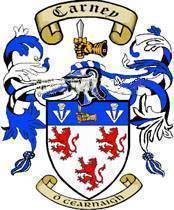
Carney & Wehofer Family
Genealogy Pages
Johannes VEHHOFER, Wehofer
-
Name Johannes VEHHOFER Suffix Wehofer Birth 1780 Rotenturm an der Pinke, Obertwart, Hungary 
Gender Male FamilySearch ID GDC7-N7R _UID 800B7B52087E4DB489B27E5FD881D247696C Death Yes, date unknown Person ID I30546 Carney Wehofer 2024 Genealogy Last Modified 26 Dec 2024
Family Elisabetha, b. 1784, Rotenturm an der Pinke, Obertwart, Hungary  d. Yes, date unknown
d. Yes, date unknown Children 1. Janos "Joannes" VEHHOFER, Vehofer, b. 1806, Rotenturm an der Pinke, Obertwart, Hungary  d. 28 Aug 1854, Bachselten, Vas Hungary
d. 28 Aug 1854, Bachselten, Vas Hungary  (Age 48 years)
(Age 48 years)Family ID F14286 Group Sheet | Family Chart Last Modified 16 Nov 2021
-
Photos 
1780 Hungary Arms.png
-
Notes - Johhanes Vehhofer was born in 1780 at Rotenturm an der Pinke, Obertwart, Hungary. Also known in Hungarian at Vasvörösvár at the time. https://en.wikipedia.org/wiki/Rotenturm_an_der_Pinka
Joannes Vehhofer is named in Filae record.
Hungarian History at the time of Johannes Vehhofer:
After 150 years of war between the Hungarians and Ottoman Turks, population growth was stunted and the network of medieval settlements with their urbanized bourgeois inhabitants perished. The 150 years of Turkish wars fundamentally changed the ethnic composition of Hungary. As a result of demographic losses, including deportations and massacres, the number of ethnic Hungarians at the end of the Turkish period was substantially diminished.
Kingdom of Hungary in the early modern period until 1848:
As the Habsburgs' control of the Turkish possessions started to increase, the ministers of Leopold I argued that he should rule Hungary as conquered territory. At the Diet of "Royal Hungary" in Pressburg, in 1687, the Emperor promised to observe all laws and privileges. Nonetheless, hereditary succession of the Habsburgs was recognized, and the nobles' right of resistance was abrogated. In 1690 Leopold began redistributing lands freed from the Turks. Protestant nobles and all other Hungarians thought disloyal by the Habsburgs lost their estates, which were given to foreigners. Vienna controlled the foreign affairs, defense, tariffs, and other functions.
The repression of Protestants and the land seizures frustrated the Hungarians, and in 1703 a peasant uprising sparked an eight-year rebellion against Habsburg rule. In Transylvania, which became the part of Hungary again at the end of the 17th century[21] (as a province, called "Principality of Transylvania" with the Diet seated at Gyulafehérvár), the people united under Francis II Rákóczi, a Roman Catholic magnate. Most of Hungary soon supported Rákóczi, and the Hungarian Diet voted to annul the Habsburgs' right to the throne. Fortunes turned against the Hungarians, however, when the Habsburgs made peace in the West and turned their full force against them. The war ended in 1711, when Count Károlyi, General of the Hungarian Armies agreed to the Treaty of Szatmár. The treaty contained the emperor's agreement to reconvene the Diet in Pressburg and to grant an amnesty for the rebels.
Leopold's successor, King Charles III (1711– 40), began building a workable relationship with Hungary after the Treaty of Szatmár. Charles asked the approval of Diet for the Pragmatic Sanction, under which the Habsburg monarch was to rule Hungary not as Emperor, but as a King subject to the restraints of Hungary's constitution and laws. He hoped that the Pragmatic Sanction would keep the Habsburg Empire intact if his daughter, Maria Theresa, succeeded him. The Diet approved the Pragmatic Sanction in 1723, and Hungary thus agreed to become a hereditary monarchy under the Habsburgs for as long as their dynasty existed. In practice, however, Charles and his successors governed almost autocratically, controlling Hungary's foreign affairs, defense, and finance but lacking the power to tax the nobles without their approval.
Charles organized the country under a centralized administration and in 1715 established a standing army under his command, which was entirely funded and manned by the non-noble population. This policy reduced the nobles' military obligation without abrogating their exemption from taxation. Charles also banned conversion to Protestantism, required civil servants to profess Catholicism, and forbade Protestant students to study abroad.
Maria Theresa (1741– 80) faced an immediate challenge from Prussia's Frederick II when she became head of the House of Habsburg. In 1741 she appeared before the Diet of Pressburg holding her newborn son and entreated Hungary's nobles to support her. They stood behind her and helped secure her rule. Maria Theresa later took measures to reinforce links with Hungary's magnates. She established special schools to attract Hungarian nobles to Vienna.
Under Charles and Maria Theresa, Hungary experienced further economic decline. Centuries of Ottoman occupation and war had reduced Hungary's population drastically, and large parts of the country's southern half were almost deserted. A labor shortage developed as landowners restored their estates. In response, the Habsburgs began to colonize Hungary with large numbers of peasants from all over Europe, especially Slovaks, Serbs, Croatians, and Germans. Many Jews also immigrated from Vienna and the empire's Polish lands near the end of the 18th century. Hungary's population more than tripled to 8 million between 1720 and 1787. However, only 39 percent of its people were Magyars, who lived mainly in the center of the country.
- Johhanes Vehhofer was born in 1780 at Rotenturm an der Pinke, Obertwart, Hungary. Also known in Hungarian at Vasvörösvár at the time. https://en.wikipedia.org/wiki/Rotenturm_an_der_Pinka
